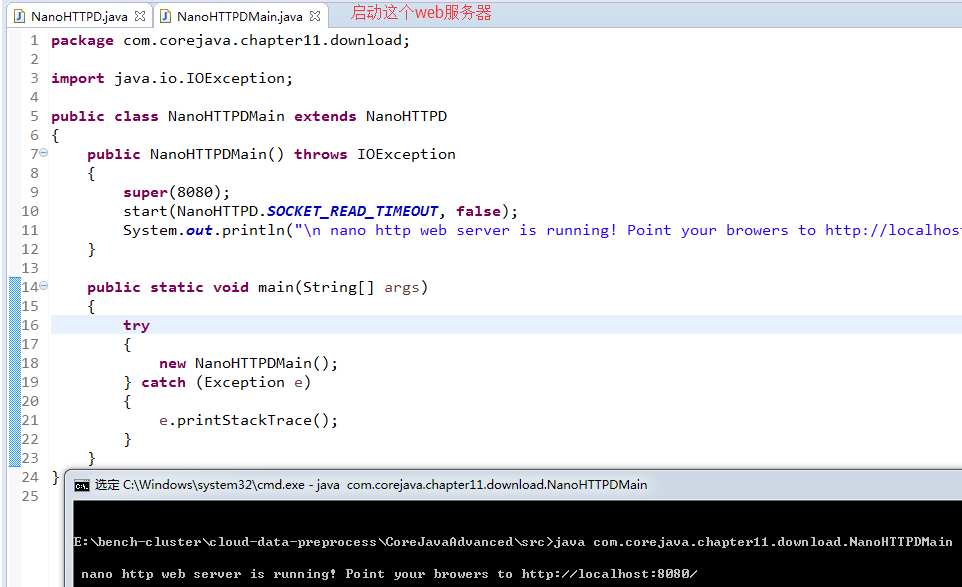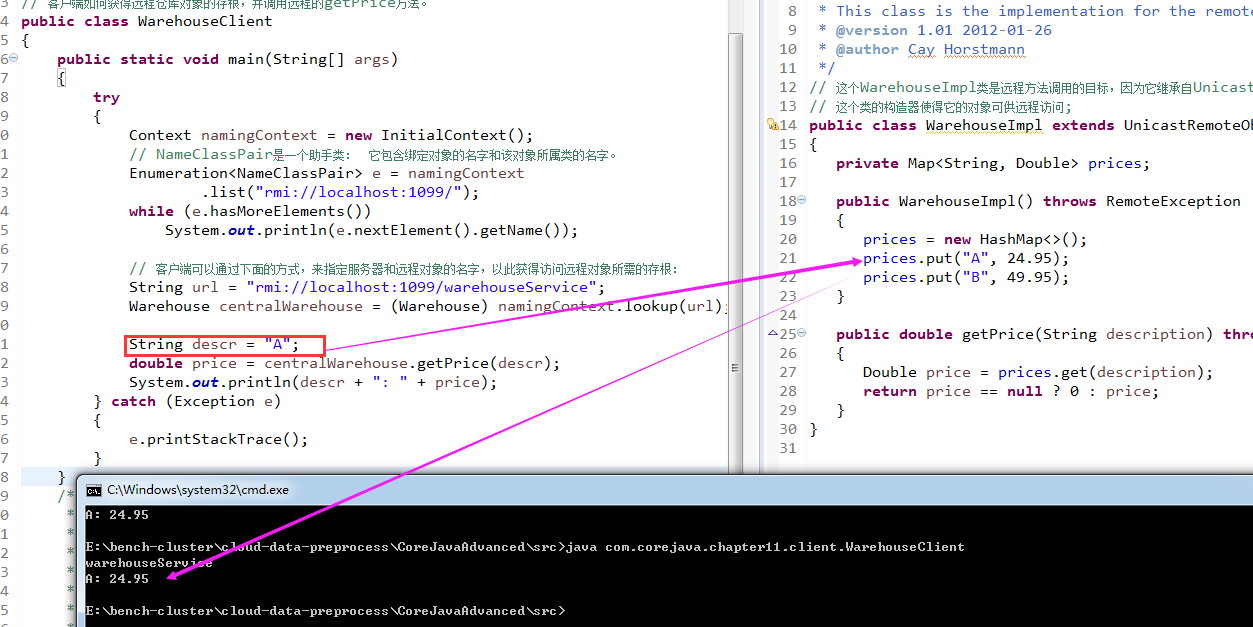【0】README
0.1)本文旨在对http://blog.csdn.net/PacosonSWJTU/article/details/50705192 中的代码进行实践(如何部署一个使用RMI框架的程序以进行远程调用);
0.2) for complete source code, please visit https://github.com/pacosonTang/core-java-volume/tree/master/coreJavaAdvanced/chapter11/rmi_test
0.3)目录结构如下:
【1】部署前的准备
step1)创建两个目录, 分别存放用于启动server 和 client 的类:
【1】部署步骤如下
step1)打开一个新的控制台窗口,转到download目录,然后将NanoHTTPD.java(NanoHTTPD web 服务器)复制到这个目录中。(NanoHTTPD web 服务器的源代码 ,参见, https://github.com/pacosonTang/core-java-volume/tree/master/coreJavaAdvanced/chapter11/rmi_test)
<span style="font-size:14px;">package com.corejava.chapter11.download;import java.io.IOException;public class NanoHTTPDMain extends NanoHTTPD
{public NanoHTTPDMain() throws IOException{super(8080);start(NanoHTTPD.SOCKET_READ_TIMEOUT, false); System.out.println("\n nano http web server is running! Point your browers to http://localhost:8080/ \n"); }public static void main(String[] args){try{new NanoHTTPDMain(); } catch (Exception e){e.printStackTrace();}}
}
</span>
step2)在server 程序中通过代码注册通讯端口和注册通讯路径
<span style="font-size:14px;">public class WarehouseServer
{public static void main(String[] args){try{WarehouseImpl warehouseService = new WarehouseImpl();// 注册通讯端口LocateRegistry.createRegistry(1099);// 注册通讯路径Naming.rebind("rmi://localhost:1099/warehouseService", warehouseService);System.out.println("warehouse service starts");} catch (Exception e){e.printStackTrace();}}
}</span>
<span style="font-size:14px;">// 这个WarehouseImpl类是远程方法调用的目标,因为它继承自UnicastRemoteObject,
// 这个类的构造器使得它的对象可供远程访问;
public class WarehouseImpl extends UnicastRemoteObject implements Warehouse
{private Map<String, Double> prices;public WarehouseImpl() throws RemoteException{prices = new HashMap<>();prices.put("A", 24.95);prices.put("B", 49.95);}public double getPrice(String description) throws RemoteException{Double price = prices.get(description);return price == null ? 0 : price;}
}</span><span style="font-size:14px;">// 远程对象的接口必须扩展Remote接口
public interface Warehouse extends Remote
{ double getPrice(String description) throws RemoteException;
}
</span>step3)现在已经准备好启动服务器了。打开第三个控制台窗口,转到server目录,并执行下面的命令:
java -Djava.rmi.server.codebase=http://localhost:8080/ WarehouseServer // java.rmi.server.codebase属性指出了服务类文件的URL。服务器程序将这个URL传递给RMI注册表。

step4)最后,打开第四个控制台窗口,转到client目录,运行:

<span style="font-size:14px;">// 客户端如何获得远程仓库对象的存根,并调用远程的getPrice方法。
public class WarehouseClient
{public static void main(String[] args){try{Context namingContext = new InitialContext();// NameClassPair是一个助手类: 它包含绑定对象的名字和该对象所属类的名字。Enumeration<NameClassPair> e = namingContext.list("rmi://localhost:1099/");while (e.hasMoreElements())System.out.println(e.nextElement().getName());// 客户端可以通过下面的方式,来指定服务器和远程对象的名字,以此获得访问远程对象所需的存根:String url = "rmi://localhost:1099/warehouseService";Warehouse centralWarehouse = (Warehouse) namingContext.lookup(url);String descr = "A";double price = centralWarehouse.getPrice(descr);System.out.println(descr + ": " + price);} catch (Exception e){e.printStackTrace();}}}</span>









开发指南)









 return null 的解决方法)
